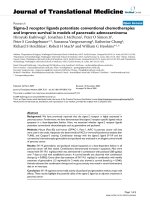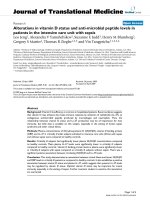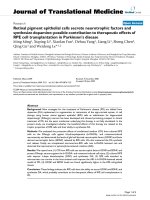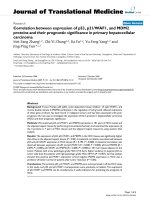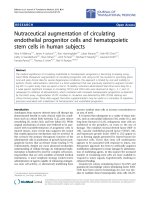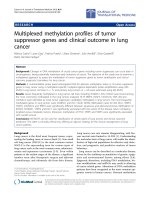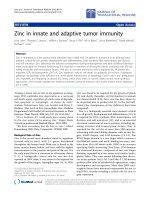báo cáo hóa học:" Security in cognitive wireless sensor networks. Challenges and open problems" potx
Bạn đang xem bản rút gọn của tài liệu. Xem và tải ngay bản đầy đủ của tài liệu tại đây (244.75 KB, 28 trang )
This Provisional PDF corresponds to the article as it appeared upon acceptance. Fully formatted
PDF and full text (HTML) versions will be made available soon.
Security in cognitive wireless sensor networks. Challenges and open problems
EURASIP Journal on Wireless Communications and Networking 2012,
2012:48 doi:10.1186/1687-1499-2012-48
Alvaro Araujo ()
Javier Blesa ()
Elena Romero ()
Daniel Villanueva ()
ISSN 1687-1499
Article type Review
Submission date 20 May 2011
Acceptance date 15 February 2012
Publication date 15 February 2012
Article URL />This peer-reviewed article was published immediately upon acceptance. It can be downloaded,
printed and distributed freely for any purposes (see copyright notice below).
For information about publishing your research in EURASIP WCN go to
/>For information about other SpringerOpen publications go to
EURASIP Journal on Wireless
Communications and
Networking
© 2012 Araujo et al. ; licensee Springer.
This is an open access article distributed under the terms of the Creative Commons Attribution License ( />which permits unrestricted use, distribution, and reproduction in any medium, provided the original work is properly cited.
Security in cognitive wireless sensor networks. Challenges and open
problems
Alvaro Araujo*
1
, Javier Blesa
1
, Elena Romero
1
and Daniel Villanueva
1
1
Electronic Engineering Department, Universidad Politécnica de Madrid,
Avda/Complutense 30, 28040 Madrid, Spain
*Corresponding author:
Email addresses:
JB:
ER:
DV:
Abstract
A cognitive wireless sensor network (CWSN) is an emerging technology with great
potential to avoid traditional wireless problems such as reliability. One of the major
challenges CWSNs face today is security. A CWSN is a special network which has
many constraints compared to a traditional wireless network and many different
features compared to a traditional wireless sensor network. While security challenges
have been widely tackled in traditional networks, this is a novel area in CWSNs. This
article discusses a wide variety of attacks on CWSNs, their taxonomy and different
security measures available to handle the attacks. Also, future challenges to be faced
are proposed.
Keywords: cognitive; security; wireless sensor networks.
1. Introduction
Global data traffic in telecommunications has an annual growth rate of over 50%.
While the growth in traffic is stunning, both the rapid adoption of wireless technology
over the globe and its penetration through all layers of society are even more amazing.
Over the span of 20 years, wireless subscription has risen to 40% of the world
population, and is expected to grow to 70% by 2015. Overall mobile data traffic is
expected to grow to 6.3 exabytes per month by 2015, a 26-fold increase over 2010 [1].
Over the recent years, wireless and mobile communications have increasingly become
popular with consumers.
In regards to wireless networks, one of the fastest growing sectors in recent years was
undoubtedly that of wireless sensor networks (WSNs). WSN consists of spatially
distributed autonomous sensors that monitor a wide range of ambient conditions and
cooperate to share data across the network. WSNs are introduced increasingly into our
daily lives. Potential fields of applications can be found, ranging from the military to
home control through commercial or industrial, to name a few. The emergence of new
wireless technologies such as Zigbee and IEEE 802.15.4 has allowed for the
development of interoperability of commercial products, which is important for
ensuring scalability and low cost.
Most WSN solutions operate in unlicensed frequency bands. In general, they use ISM
bands, like, the worldwide available 2.4 GHz band. This band is also used by a large
number of popular wireless applications, for example, those that work over Wi-Fi or
Bluetooth. For this reason, the unlicensed spectrum bands are becoming overcrowded
with the increasing use of WSN-based systems. As a result, coexistence issues in
unlicensed bands have been subject of extensive research [2, 3], and in particular, it
has been shown that IEEE 802.11 networks [4] can significantly degrade the
performance of Zigbee/802.15.4 networks when operating in overlapping frequency
bands [3].
The increasing demand for wireless communication presents an efficient spectrum
utilization challenge. To address this challenge, cognitive radio (CR) has emerged as
the key technology, which enables opportunistic access to the spectrum. A CR is an
intelligent wireless communication system that is aware of its surrounding
environment, and adapts its internal parameters to achieve reliable and efficient
communication [5].
The main different between traditional WSN and new cognitive wireless sensor
network (CWSN) paradigm is that in CWSN nodes change their transmission and
reception parameters according to the radio environment. Cognitive capabilities are
based in four technical components: sensing spectrum monitoring, analysis and
environment characterization, optimization for the best communication strategy based
on different constrains (reliability, power consumption, security, etc.) and adaptation
and collaboration strategy.
Adding those cognition capabilities to the existing WSN infrastructure will bring about
many benefits. In fact, WSN is one of the areas with the highest demand for cognitive
networking. In WSN, node resources are constrained mainly in terms of battery and
computation power but also in terms of spectrum availability.
Hence with cognitive capabilities, WSN could find a free channel in the unlicensed
band to transmit or could find a free channel in the licensed band to communicate.
CWSN could provide access not only to new spectrum (rather than the worldwide
available 2.4 GHz band), but also to the spectrum with better propagation
characteristics. A channel decision of lower frequency leads more advantages in a
CWSN such us higher transmission range, fewer sensor nodes required to cover a
specific area and lower energy consumption.
However, the cognitive technology will not only provide access to new spectrum but
also provides better propagation characteristics. By adaptively changing system
parameters like modulation schemes, transmit power, carrier frequency and
constellation size, a wide variety of data rates can be achieved. This will certainly
improve power consumption, network life and reliability in a WSN. Adding cognition
to a WSN provides many advantages.
This way, CWSN is a new concept proposed in literature [6] with the following
advantages.
• Higher transmission range.
• Fewer sensor nodes required to cover a specific area.
• Better use of the spectrum
• Lower energy consumption.
• Better communication quality.
• Lower delays.
• Better data reliability.
Despite the research interest in CWSN, security aspects have not yet been fully
explored even though security will likely play a key role in the long-term commercial
viability of the technology. The security paradigms are often inherited from WSN and
do not fit with the specifications of CR networks. Looking at the literature related to
CR, security researchers have seen that CR has special characteristics. This make CR
security an interesting research field, since more chances are given to attackers by CR
technology compared to general wireless networks. However, at present there are no
specific secure protocols which integrate WSN and CR needs.
At this, still immature, point of CR, it is important to understand some fundamental
issues such as potential threats, potential attacks and the consequences of these attacks.
As [7] says, the CR nature of the system introduces an entire new suite of threats and
tactics that are not easily mitigated. The three main characteristics of CR are
environment awareness, learning and acting capacity. At first, these characteristics
should be an advantage against attacks but they can become in weaknesses. For
example, CR nodes collaborate to make better decisions but these communications are
ways to propagate the attack in the network.
Considering these characteristics since the attacker point of view, the fundamental
differences between a traditional WSN and the CWSN network are
• The potential far reach and long-lasting nature of an attack.
• The ability to have a profound effect on network performance and behaviour
through simple spectral manipulation.
The information sensed in a CRN is used to construct a perceived environment that
will impact in a certain way in current and future behaviour s of all the nodes in the
network. The induction of an incorrectly perceived environment will cause the wrong
adaptation of the CRN, which could affect short-term behaviour but also because of
their ability to learn, it will propagate the error to the new decisions. Thus, the
malicious attacker has the opportunity for long-term impact on behaviour.
Furthermore, CR collaborates with its fellow radios sharing information.
Consequently, this provides an opportunity to propagate behaviour through the
different networks.
Threats associated with each CRN features can be detected [7], such as
• Maintains awareness of surrounding environment and internal state. It could be
an opportunity for spoofing that will send malicious data to the environment to
provoke an erroneously perception.
• Adapts to its environment to meet requirements and goals. It is an opportunity
to force desired changes in behaviour in the victim.
• Reasons on observations to adjust adaptation goals. It could be an opportunity
to influence fundamental behaviour of CRN.
• Learns from previous experiences to recognize conditions and enables faster
reaction times. This could an opportunity to affect long-lasting impact on CR
behaviour.
• Anticipates events in support of future decisions. It could be an opportunity for
long-lasting impact due to an erroneous prediction.
• Collaborates with other devices to make decisions based on collective
observations and knowledge. This is an opportunity to propagate an attack through
network.
• Wireless communication. Data might be eavesdropped and altered without
notice; and the channel might be jammed and overused by adversary. Access control,
confidentiality, authentication and integrity must be guaranteed.
On the other hand, CRN features also help to mitigate malicious manipulation using:
• The ability to collaborate for authentication of local observations that are used
to form perceived environments.
• The ability to learn from previous attacks.
• The ability to anticipate behaviours to prevent attacks.
• The ability to perform self-behaviour analysis.
Despite the extensive volume of research results on WSN [8], the considerable amount
of ongoing research efforts on CR networks [9], and the new interest in CWSN [10],
security in CWSN is vastly unexplored field. This is a new paradigm that offers many
research opportunities.
The organization of this article is as follows. In Section 2, works in security are
reviewed. In Section 3, a new taxonomy of attacks is proposed. In Section 4,
countermeasures for CWSN attacks are analysed. Challenges and open works are
shown in Section 5. Conclusions are offered in Section 6.
2. Related work
First works about security in CR were developed specifically to analyse the effects
produced by cognitive features and how they could be used to mitigate the negative
effects. So, as we have said, in the article [7] each characteristic and the attacks that
could take advantage of it are analysed. A different point of view is shown in the
article of Zhang and Li [11].They make a survey about the weaknesses introduced by
the nature of CR. They base the security of the system in two tasks: protection and
detection, and divide the attacks and countermeasures depending on which layer of the
protocol stack affects. The article [12] studies threats that affect the ability to learn of
cognitive networks and the dynamic spectrum access. To conclude the general
references about security, it should be noted the article of Goergen and Clancy [9]
where an attack classification in cognitive networks is done: DSA attacks, objective
function attacks and malicious behaviour attacks.
In [13], two specific attacks against cognitive networks are analysed: primary user
emulation (PUE), and sensing data falsification. It also provides some
countermeasures well adapted to static scenarios such as TV system. In [14], a secure
protocol spectrum sensing is presented. It bases its functionality on the generation and
transmission of specific keys to each node. As a third example of safety sensing
investigation, the research [15] proposes a collaborative algorithm based on energy
detection and weighted combining (similar to a reputation system) to prevent
malicious users.
Related to specifics attacks, the most studied against CR is the PUE, which was
defined by Chen and Park [16] for the first time in 2006. Since then, research of the
same authors [17] has focused on countermeasures against PUE. Also, in [18] a way to
detect the PUs through an analytical model that does not require location information
is shown. As well as the PUE attack, the community of researchers in CR has been
studying other kind of attacks originate from different wireless networks, such as
denial of service (DoS) attack or jamming attack. These attacks have special
characteristics in cognitive networks, for example, article [19] studies these features
for DoS, and [20] shows a countermeasure based on frequency hopping (technically
possible in CR) to avoid jamming attacks.
Although previous articles help to understand the importance of securing CRNs [21–
23] they do not take into account the specific characteristics of WSN.
On the other side, there are several articles related with security in WSNs, a topic very
studied [8, 24–27], but without using cognitive capabilities.
Summarizing the state of the art, there is still much to investigate in the area of
security for CWSNs, because nowadays there is not any work focus on this topic.
3. Taxonomy of attacks in CWSNs
As we shown in Section 1, CWSNs have special features that make security really
interesting. However, security in CWSNs needs to be more studied by scientific
community.
In this section, a complete taxonomy of attacks for CWSNs is shown. We are going to
compare the differences in the scope between these attacks in a traditional WSN and in
a cognitive one.
A taxonomy of attacks on CWSNs is very useful to design optimistic security
mechanisms. There are several taxonomies of attacks on wireless networks [10] and
focus on WSNs [6]. Moreover, some classifications of attacks in CR exist [3, 9, 11].
However, there is not a deep classification of attacks in CWSNs and study of attacks
against cognitive WSNs does not exist.
We have analysed special network features that make CWSNs better against attacks:
high transmission range, lower energy consumption, low delays and reliability of data.
Their security is obviously endangered by the medium used, radio waves, but also by
specific vulnerabilities of CWSNs like battery life or low computational resources.
Considering theses features, we propose a taxonomy which contains various attacks
with different purposes, behaviours and targets. This will help researchers to better
understand the principles of attacks in CWSNs, and further design more optimistic
countermeasures for sensor networks. Figure 1 shows an outline of this CWSN
taxonomy of attacks. CWSN attacks are divided into communications, against privacy,
node-targeted, power consumption, policy and cryptographic attacks.
3.1. Communication attacks
First group is communication attacks. In this kind of attacks the attacker affects data
transmissions between nodes with a concrete purpose. The goal could be from isolate a
node to try to change the behaviour of whole network.
Communication attacks can be classified into three different types according to the
attack behaviour: replay attack, DoS attack and Sybil attack. Replay attack [28]
consists on the replay of messages from inside or outside the current run of
communication. For example, message is directed to other than the intended node.
This receiver node replays the message to the intended principal and this receives the
delayed message. This delay is fundamental to calculate network characteristics
(channel, topology, routing, etc.). CWSN could be affected in more degree that a
regular WSN because nodes share information about the environment. If a node
receives wrong information and also repeated, network behaviour could be affected
deeply. If the PU packets are repeated, SU could have a wrong perspective of the
spectrum too, avoiding the communications in frequencies or protocols used by the
attacker.
DoS attack is characterized by an explicit attempt to present the legitimate use of a
service. In this case, services are the spectrum or a special node. Different kinds of
DoS attacks are
• Jamming attack, the transmission of a radio signal that interferes with the radio
frequencies used by nodes. Jamming attack is one of the most studied attacks against
WSN [29]. However, CWSN has great advantages to solve jamming but also can
produce negative effects like energy consumption or communication failures. A typical
jamming attack is a high power transmission using the PU frequency.
• Collision attack [30] consist of the intention of violate the communication
protocol. This attack does not consume much energy of the attacker but can cause a lot
of disruptions to the network operation. Due to the wireless broadcast nature, it is not
trivial to identify the attacker. For example, the secondary users (SUs) have to share
the spectrum. Therefore, the use of this type of attack is very efficient in order to
disrupt the SU communication. Nodes, detecting collisions, will relay the information,
making communication very difficult.
• Routing ill-directing attack. In this attack, a malicious node simply refuses to
route messages. Examples of this kind of attacks are the grey hole and black hole ones.
In these attacks, the nodes refuse all packets that arrive or a percentage thereof.
Because of this misinformation, the network can change the routes, the topology or
leaving isolated nodes.
• In flooding attack, a malicious node sends many connection request to a
susceptible node, rendering the node or the resource useless. For instance, a joint
network request to the coordinator node.
Sybil attack is defined as a malicious device illegitimately taking multiple identities.
Sybil attack is effective against routing algorithms, voting, reputation systems and
foiling misbehaviour detection. For instance, Sybil attack might utilize multiple
identities to generate additional reputation to malicious nodes or to change the sensing
spectrum information. The most studied attack against CR is the PUE.
3.2. Against privacy attacks
The other important attack class is attacks against privacy. CWSNs allow sharing
resources to establish a communication and to be aware of environment. Attackers
could use this access to take some of node information. The attacks against node
privacy include eavesdropping, through taping the information; the attacker could
easily discover the communication contents. Impersonating attack, where the attacker
joins to the network and it can impersonate the original victim sensor node to receive
packet, and traffic analysis, using wireless and cognitive features to listen in the entire
spectrum. Traffic analysis attacks [31] try to deduce the context information of nodes
analysing the traffic pattern from eavesdropping on wireless communication. Acquired
information could be used to prepare a most harmful attack. For example, spectrum
information can be used to know what the weakest spectrum zone is or where the PUs
are emitting.
3.3. Node-targeted attacks
Node-targeted attacks need more attention that in a normal WSN because of the
propagation of information is more important for the correct working of CWSN. A
node can be captured [32, 33] and attackers use reverse-engineered and become an
instrument for mounting counterattacks. Other possibility is to destroy the nodes. This
destruction not only affects to node functionality, but also affects whole network.
Usually, node-targeted attacks ought to be less important for WSN. However,
distributed information and co-operational behaviour in CWSN make a captured node
a powerful weapon for attackers. Extracting a cryptographic key and modifying the
internal device code are examples of node-targeted attacks.
3.4. Power consumption attacks
Battery life in WSN is a crucial factor. Small size of nodes and batteries makes CWSN
very vulnerable to power consumption attacks. The attacker can inflict sleep torture on
an energy constrained node by engaging in it unnecessary communication work to
quickly drain its battery power. Depriving the power of a few crucial nodes (e.g.
Access Point) may lead communication breakdown of the entire network. Attacker
node can request a channel change every time, increasing power consumption.
3.5. Policy attacks
The security and privacy policies are imperative since the policy basically influences
the setup principles of a CWSN. Policy attacks can be classified as:
• Excuse attack, if the network policy is overly generous to recovering nodes that
recently crashed or damaged by no requiring them to prove there are maintaining their
quota, a malicious node may exploit this attack by repeatedly claiming to have been
crashed/damaged. In this way, for instance, wrong spectrum information can be sent to
the network very often to change the communications.
• Newbie-picking attack, if a CWSN requires that new nodes pay their dues by
requiring them to give information to the net for some period of the time before they
can consume any shared resource, therefore a veteran node could move from one
newbie node to another, leeching their information without being required to give any
information back.
3.6. Cryptographic attacks
Concluding the taxonomy, the cryptographic attacks try to find the weaknesses in
system analysing the information transmitted. Several cryptographic attacks exist but
their objectives are the same: to acquire the cryptographic key, to identify weakness in
the algorithms or in the node software. CWSN nodes do not have enough resources to
implement a powerful cryptographic code and they are vulnerable to these attacks.
Apart from the above listed attacks that may hinder the key management of CWSNs,
the following actions will also danger the key management within CWSNs: brute
forces, dictionary attack and monitoring attack. One example of this kind of attack is
Differential Power Analysis (DPA) attack. The DPA attack can be used to target an
unsuspecting victim either by using special equipment that measures electromagnetic
signals emitted by chips inside the device or by attaching a sensor to the device’s
power supply.
4. Countermeasures in CWSN
According to Section 3 is very clear that CWSN face a dangerous problem in security.
Several attacks could be adapted from WSN to the new paradigm of cognitive
networks. In the last 10 years, some researches related with security on CRN have
appeared. They related specific attacks against these networks but a few
countermeasures are proposed. In this section, we show three different groups of
countermeasures according to the specific characteristics of CWSN.
4.1. Based on geolocation
CR has it’s origin in United States where an important problem with the spectrum
occupancy becomes real. The main reason is that the access to the radio spectrum is
ruled by a restrictive regulatory regime that emerged when the Radio Act of 1927
declared the “ether” to be a publicly owned resource. The goal of CR was to use the
radio spectrum when base stations did not transmit.
According to that, first real and simulated scenarios were static, with base stations
making the role of PU and different devices like SU. If an attacker tries to emulate a
PU the geolocation is an efficient method [18, 34]. For example, in [34] the authors
assume that the attacker is close to the victim and the real PU is much far from the SU
and the attacker. Moreover, the position of each node, including the attacker, is fixed.
Assuming that, SU can learn about the characteristics of the spectrum according to the
received power.
Geolocation countermeasure does not work for most of cases in CWSN scenarios,
almost with the same approach that previous mentioned papers. In a regular WSN,
nodes can change their location, even attackers can change it. In fact, attackers have in
the movement a great advantage to not be detected.
Another disadvantage of node mobility related to security is that if we would like to
monitor PU we need to sense continuously the spectrum to detect new locations. The
continuous sensing reduces node batteries. Moreover, if the PU could be in any spatial
point, its location is irrelevant for security. For example, a mobile phone with Wi-Fi
could be a PU and this device could stay in any location. Others parameters should be
observed to differentiate between PU and an attacker.
To conclude, if we want to use a countermeasure based on geolocation, some
restriction should be defined. For example, restricted areas for attackers or fixed
number of PU in the scenario.
4.2. Based on behaviour
In the same way that geolocation countermeasures, defences based on behaviour tries
to modelling the PU [35]. The model is used to look for differences between a PU and
attackers.
For example, in [17] authors use some radio parameters to decide if the transmitter is
an incumbent transmitter or an attacker. These parameters are: signal characteristics,
transmitted power and location. For a typical TV scenario on CR the PU model could
be very precise. However as in geolocation countermeasures, the previous studies do
not work for CWSN. Unfortunately it does not exist any model for PU in CWSN yet.
PU usually are more unpredictable that in previous scenarios.
However, if we focus our CWSN in limited scenarios, for example intelligence
ambient in a home or a building, the PU is defined specifically. Parameters like power
transmission, time occupancy of spectrum and frequency used could be detected.
Genetic or Self-Organizing Maps algorithms could be used to detect the PUs
behaviour and to difference them against attackers. These algorithms can detect
patterns and behaviour changes, so they are a good solution for this problem.
However, computational cost and batteries life should be taking in account.
4.3. Based on reputation and trust of the CR nodes
Two different groups of countermeasures related with the location and behaviour are
proposed. Third group is a complement for the previous solutions that could improve
the detection of attacks.
Reputation systems are very common in WSN [36]. Reputation takes advantage from
the own characteristics of WSN: redundancy and adaptation. Usually several sensors
form the networks and information is replied. Redundancy can be used to detect and
isolate faulty or compromised nodes.
In CWSN where information is essential for the cognitive behaviour and sharing
information is almost compulsory, reputation system can describe if the primary and
SUs act like we expect. The big amount of information supplies the reputation system
adjusting the reputation and trust of any node.
The best advantage of reputation systems is their versatility. The countermeasures
could be implemented in any device, even small sensors with low resources, and could
be used, in combination with others attacks, against most of attacks of Section 0.
5. Challenges and open problems
The nature of large, dynamic, adaptive, cognitive WSNs presents significant
challenges in designing security schemes. A cognitive WSN is a special network
which has many constraints compared to a traditional wireless network and many
different features compared with a traditional WSN. While security challenges have
been widely tackled in traditional networks, is a novel area in CWSN. In this section,
most important challenges are discussed.
The wireless medium is inherently less secure because its broadcast nature makes
eavesdropping simple. Any transmission can easily be intercepted, altered or replayed
by an adversary. The wireless medium allows an attacker to easily intercept valid
packets and easily inject malicious ones. Cognitive features allow a dynamic
reconfiguration to avoid these attacks. However, malicious nodes can use the dynamic
reconfiguration to create new attacks such us PUE. CWSNs have to adapt traditional
wireless problems to cognitive networks and provide solutions to new problems.
The dynamic nature of sensor networks means no structure can be statically defined.
Cognitive approach includes new dynamic issues: communication protocol,
modulation, frequency, sensibility or emitted power. The attacker can use these
powerful characteristics to affect the data transmissions between nodes with a concrete
purpose. The goal could be from isolate a node to try to change the behaviour of entire
network. Security schemes must be able to operate within this dynamic environment.
The next challenging factor is the hostile environment in which cognitive sensor nodes
function. Nodes face the possibility of destruction or capture by attackers. Since nodes
may be in a hostile environment, attackers can easily gain physical access to the
devices. Attackers may capture a node, physically disassemble it, and extract from it
valuable information (e.g. cryptographic keys). Because of the capacity of change the
communication protocol, a capture node can affect to the whole network. For example,
a malicious node can order to the network use a specific modulation or cryptographic
algorithm and capture all the data. Also node can provide wrong information to the
network causing a bad configuration. The ability to have a profound effect on network
performance and behaviour through simple spectral manipulation is very dangerous.
The highly hostile environment represents a serious challenge for security researchers.
The extreme resource limitations of CWSN devices pose considerable challenges to
resource–hungry security mechanisms. The hardware constraints necessitate extremely
efficient security algorithms in terms of bandwidth, computational complexity and
memory. This is no trivial task. Energy is the most precious resource for these
networks. Communication and cognitive algorithms are especially expensive in terms
of power. Cognitive networks usually reduce power emission to save batteries.
Attacker can isolate a node easily. Clearly, security mechanisms must give special
effort to be communication efficient in order to be energy efficient.
The proposed scale of cognitive WSNs poses a significant challenge for security
mechanisms. Cognitive networks are not only hundreds of sensors; they can also
include different wireless interfaces and integrate a myriad of nodes in the same
network. Providing security over such a network is equally challenging. Security
mechanisms must be scalable to very large networks with different radio interfaces
while maintaining high computation and communication efficiency.
One of the main goals of CWSNs is to allow a reliable communication. Certainly,
unreliable communication is another threat to nodes security. The security of the
network relies heavily on a defined protocol, which in turn depends on
communication. Even if the channel is reliable, the communication may still be
unreliable. The multi-hop routing, network congestion and node processing can lead to
greater latency in the network, thus making it difficult to achieve synchronization
among sensor nodes to change the communication scheme.
Depending on the function of the particular sensor network, the sensor nodes may be
left unattended for long periods of time. There are two main cautions to unattended
sensor nodes: exposure to physical attacks and managed remotely. Remote
management of a sensor network makes it virtually impossible to detect physical
tampering or DPA attack. Perhaps most importantly, the longer that a sensor is left
unattended the more likely that an adversary has compromised the node.
CWSNs have a special feature for security mechanism: dynamic reconfiguration
network scheme. Level security can adapts to a specific application, network topology,
power and other constraints. Security level reconfiguration biased by different
constraints has to be considered in order to improve network security.
6. Conclusions
CWSNs are increasingly being used in military, environmental, health and commercial
applications. These networks are inherently different from traditional wireless
networks as well as WSNs. Security is a mandatory feature for the deployment of
CWSNs. This article summarizes the attacks and their taxonomy and also an attempt
has been made to explore the security mechanisms widely used to handle those attacks.
The challenges of WSNs are also briefly discussed. Security issues are a novel
research area. This survey will hopefully motivate future researchers to design smarter
and more robust security mechanisms and make their networks safer.
Competing interests
The authors declare that they have no competing interests.
Acknowledgments
This study was funded by the Spanish Ministry of Science and Innovation, under
Research Grant AMILCAR TEC2009-14595-C02-01, and the P8/08 within the
National Plan for Scientific Research, Development and Technological Innovation
2008-2011.
References
[1] Cisco Systems Inc., Cisco Visual Networking Index: Global Mobile Data
Traffic Forecast Update, 2010–2015. White Paper, February 2011
[2] I Howitt, J Gutierrez, IEEE 802.15.4 low rate—wireless personal area network
coexistence issues, in Proceedings of IEEE Wireless Communications and Networking
Conference (WCNC), New Orleans, Louisiana, USA, March 2003, vol.3, pp.1481-
1486
[3] D Cavalcanti, R Schmitt, A Soomro, Achieving energy efficiency and QoS for
low-rate applications with 802.11e, in IEEE Wireless Communications and
Networking Conference (WCNC), Hong Kong, March 2007, vol.1, pp.2143-2148
[4] IEEE 802.11 Standard, Wireless LAN medium access control (MAC) and
physical layer (PHY) specifications, 1999 (Reaff 2003) Edition
[5] J Mitola, Cognitive radio: an integrated agent architecture for software defined
RADIO, Ph.D. dissertation, Royal Institute of Technology, Stockholm, Sweden, 2000
[6] D Cavalcanti, S Das, J Wang, K Challapali, Cognitive radio based wireless
sensor networks, in Proceedings of 17th International Conference on Computer
Communications and Networks, St. Thomas, U.S. Virgin Islands, August 2008, vol.1,
pp.1-6
[7] JL Burbank, Security in cognitive radio networks: the required evolution in
approaches to wireless network security, in 3rd International Conference on Cognitive
Radio Oriented Wireless Networks and Communications, (CrownCom), Singapore,
May 2008, vol.1, pp.1-7, 15-17
[8] D Xiaojiang, C Hsiao-Hwa, Security in wireless sensor networks. IEEE Wirel.
Commun. 15(4), 60–66 (2008).
[9] TC Clancy, N Goergen, Security in cognitive radio networks: threats and
mitigation, in 3rd International Conference on Cognitive Radio Oriented Wireless
Networks and Communications, (CrownCom) Singapore, May 2008, vol.1, pp. 1–8
[10] AS Zahmati, S Hussain, X Fernando, A Grami, Cognitive wireless sensor
networks: emerging topics and recent challenges, in IEEE International Conference
Science and Technology for Humanity (TIC-STH), Toronto, Canada, September 2009,
vol.1, pp.593-596
[11] X Zhang, C Li, The security in cognitive radio networks: a survey, in
Proceedings of the International Conference on Wireless Communications and Mobile
Computing: Connecting the World Wirelessly (IWCMC). (ACM, New York, NY,
2009), vol.1, pp. 309–313
[12] Y Zhang, G Xu, X Geng, Security threats in cognitive radio networks, in
Proceedings of the 10th IEEE international Conference on High Performance
Computing and Communications (HPCC). Dalian, China, September 2008), vol.1, pp.
1036–1041
[13] C Ruiliang, P Jung-Min, YT Hou, JH Reed, Toward secure distributed
spectrum sensing in cognitive radio networks. IEEE Commun. Mag. 46, 50–55 (2008)
[14] G Jakimoski, KP Subbalakshmi, Towards secure spectrum decision, in
Proceedings of IEEE Intl. Conference on Communications. (ICC), Piscataway, NJ,
USA, June 2009, vol.1, pp. 2759-2763
[15] T Zhao, Y Zhao, A new cooperative detection technique with malicious user
suppression, in Proceedings of IEEE Intl. Conference on Communications
(ICC),Dresden, Germany, June 2009, vol.1, pp. 14-18
[16] R Chen, JM Park, Ensuring trustworthy spectrum sensing in cognitive radio
networks, in 1st IEEE Workshop on Networking Technologies for Software Defined
Radio Networks, (SDR), Orlando, Florida, USA, September 2006, vol.1, pp. 110–119
[17] R Chen, JM Park, JH Reed, Defense against primary user emulation attacks in
cognitive radio networks. IEEE J. Sel. Areas Commun. 26(1), 25–37 (2008)
[18] Z Jin, S Anand, KP Subbalakshmi, Detecting primary user emulation attacks in
dynamic spectrum access networks, in IEEE International Conference on
Communications, (ICC), Dresden, Germany, June 2009, vol.1, pp. 14-18
[19] TX Brown, A Sethi, Potential cognitive radio denial-of-service vulnerailities
and protection countermeasures: a multi-dimensional analysis and assessment, in 2nd
International Conference on Cognitive Radio Oriented Wireless Networks and
Communications, (CrownCom), Orlando, Florida, USA, July 2007, vol.1, pp. 456–464
[20] L Zhang; J Ren, T Li, Spectrally efficient anti-jamming system design using
message-driven frequency hopping, in IEEE International Conference on
Communications (ICC), Dresden, Germany, June 2009, vol.1, pp. 1-5
[21] G Baldini, T Sturman, A Biswas, R Leschhorn, G Godor, M Street, Security
aspects in software defined radio and cognitive radio networks: a survey and a way
ahead. IEEE Commun. Surv. Tutor., 2011, vol.99, pp. 1–25
[22] A Sethi, TX Brown, Hammer model threat assessment of cognitive radio denial
of service attacks, in 3rd IEEE Symposium on New Frontiers in Dynamic Spectrum
Access Networks, (DySPAN), Chicago, USA, October 2008, vol.1, pp. 1–12
[23] S Arkoulis, L Kazatzopoulos, C Delakouridis, GF Marias, Cognitive spectrum
and its security issues, in Proceedings of The Second International Conference on Next
Generation Mobile Applications, Services, and Technologies (NGMAST), Cardiff,
Wales, UK, September 2008, vol.1, pp. 565–570
[24] JP Walters, Z Liang, W Shi, V Chaudhary, Wireless sensor network security: a
survey, ed. by Y Xiao. Security in Distributed, Grid, and Pervasive Computing,
Auerbach Publications, CRC Press, New York, USA, 2006
[25] W Yong, G Attebury, B Ramamurthy, A survey of security issues in wireless
sensor networks. IEEE Commun. Surv. Tutor. 8(2), 2–23 (2006)
[26] Y Zhou, Y Fang, Y Zhang, Securing wireless sensor networks: a survey. IEEE
Commun. Surv. Tutor. 10(3), 6–28 (2008)
[27] D Martins, H Guyennet, Wireless sensor network attacks and security
mechanisms: a short survey, in 13th International Conference on Network-Based

